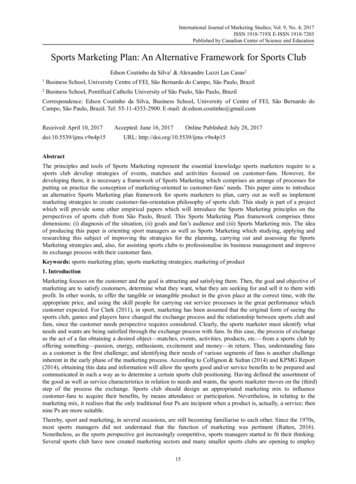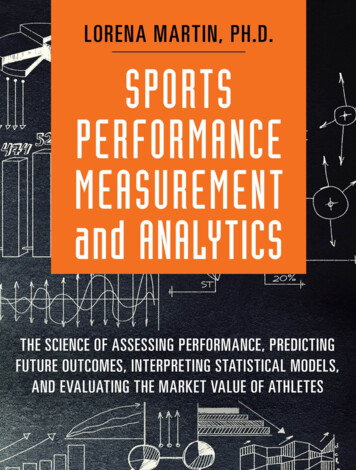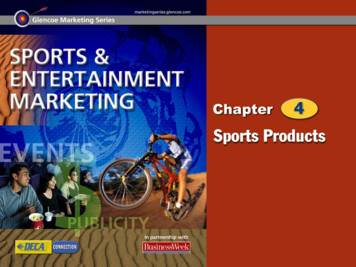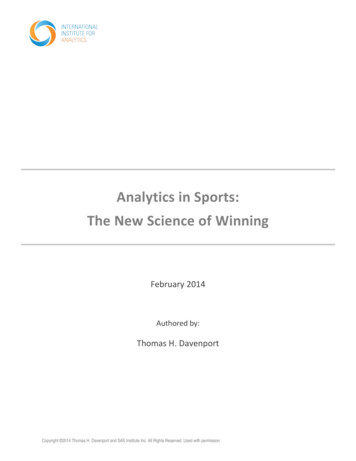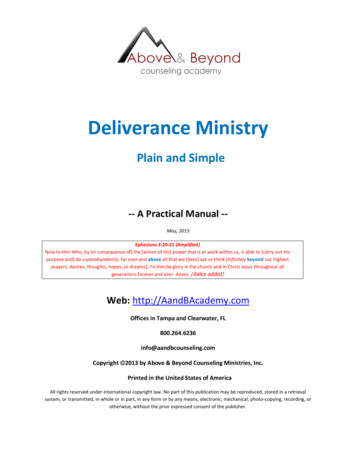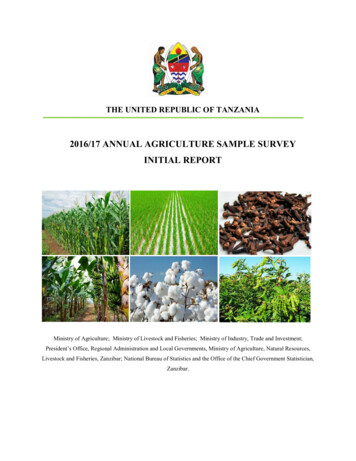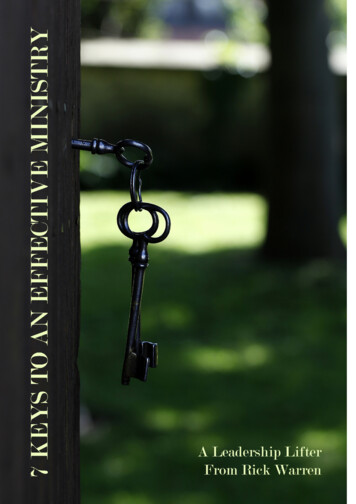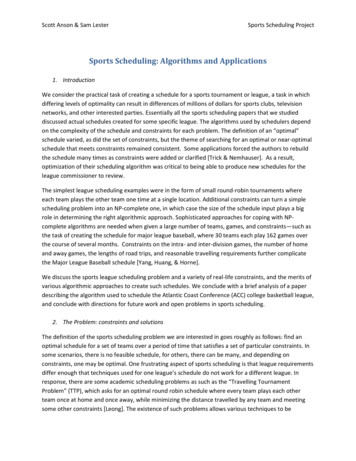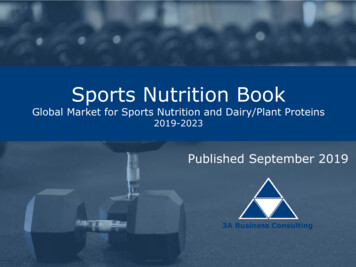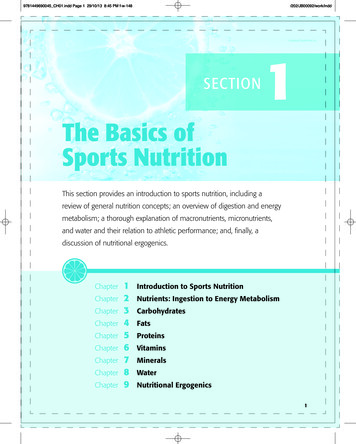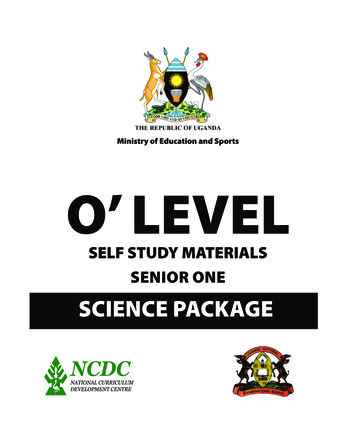
Transcription
Ministry of Education and SportsO’ LEVELSELF STUDY MATERIALSSENIOR ONESCIENCE PACKAGE
CHEMISTRYTOPIC ONE: CHEMISTRY AND SOCIETYQuestionActivity 4.1Learning OutcomesWhat careers require the study and knowledge ofChemistry? Write the solutions in your chemistry notebook.Complete the following statements by filling in the blankspacesAfter going through the activities in this topic you should beable to;i)know the appropriate activities to explain the distinctnature of Chemistry.ii) understand why chemistry is studied and how it overlapswith other subjects such as Biology, Physics, Mathematicsand Geography.iii) understand the importance of chemistry and relateknowledge of chemistry to relevant careers.iv) know the contribution of chemistry to the Ugandaneconomy.Lesson One: The Nature of ChemistryINTRODUCTIONIn primary seven you learnt about integrated science. Ihope you remember what integrated science is.Here in secondary school, we have science separatedinto mainly three(3) branches and those are: Biology: deals with living things.Physics: deals with relationship betweenenergy and matter.Chemistry: (you will find out about this in awhile)In this lesson, we shall find out what Chemistry dealswith and also the common things we use in everydaylife that are made with the knowledge of Chemistry, bycarrying out the given activities.ACTIVITY 1.1Identify the common things we use in everyday life thatyou think are made of chemicals. Write your findings inyour chemistry note book.ACTIVITY 1.2INSTRUCTIONS Look for the following products/items and assemblethem in one place. Bar soap, Vim, Toilet paper, Jik, Soda, Tooth paste,Pens, Detergent (e.g Omo,sunlight,Nomi),mineralwater bottle,a cloth,a comb,shoe polish,abook,Tomato sauce,Blueband Observe the products/items critically and answerthe given questions, answers should be written inyour chemistry note book.a) Give at least one use of each of the products/items.b) Are these products a result of the knowledge ofChemistry?c) Name any other products produced using theknowledge of Chemistry.CONCLUSIONChemistry is all around us. The common chemicals inpharmaceuticals, cosmetics, plastics, foods&beverages,soaps&detergents, water treatment, alcohol preparationat home, are all related to Chemistry.2 National Curriculum Development Centre, 2020Lesson Two: The Meaning of ChemistryIntroductionChemistry deals with the study of materials thatmake up our world. Carry out the following activities toexplore the meaning of chemistry further.Activity 2.1.Steps1.Burn a piece of paper using a lighted match stick.Observe and write the changes that happen to the paperduring the burning.2.Now consider the following processes that take placein everyday life;i)the rusting of a pangaii)the boiling of wateriii)the rotting of fruitsa)What changes take place in each of the givenprocesses above(i-iii)?b)What are the necessary conditions for each of theabove changes to take place?3.Name any other processes in which materials changefrom one form to another?ConclusionThe changes you have just observed and many othersshow what the study of chemistry is about.Therefore, Chemistry is the study of matter and the changesthat occur to substances under different conditions.Lesson Three: Why Is Chemistry Studied And How ItOverlaps With Other Subjects?Chemistry helps us to; Understand what different materials/substances aremade of and their properties, some are poisonous,corrosive, toxic, etc Know the effects of chemicals to the environmenthence we learn how to conserve and protect ourenvironment. Get knowledge to advance in science andtechnology for better and quality human life. Acquire knowledge relevant in making newmaterials which are relevant and useful in oureveryday life e.g making of food supplements,distillation of crude oil, making of plastics, making ofcosmetics, making of dental creams, manufacture ofsoap&detergents, making of insecticides&herbicides,etc Get knowledge and skills of how to extract and usematerials from the earth e.g Gold, Copper,etcACTIVITY 3.1Using relevant Chemistry text books and the internet,research about more reasons why Chemistry should bestudied and how Chemistry relates with other subjects.Write your findings in your Chemistry note book.Lesson Four: Importance of Chemistry in EverydayLife.There are many examples of chemistry in everyday lifewhich show how prevalent and important chemistry is. Digestion relies on chemical reactions between . and enzymes to breakdown largesubstances into that the body can .Soaps and . are chemical substances that“dissolve” when we wash our clothes, . and Drugs work because of chemistry and its chemistryknowledge helps us know which drugs are . or harmful to us as humans.Cooking is a chemical change that alters food tomake it .,kills dangerous andmakes food more ACTIVITY 4.1Summarise the mentioned examples in your chemistrynote book. Use the internet and research for more wayshow chemistry is important in everyday life, write yourfindings in your chemistry note book.Lesson Five: Contribution of Chemistry to TheEconomy of Uganda.ACTIVITY 5.1Using the knowledge of common industrial products inour country and their uses, ask older people around you,use books/magazines/newspapers and also the internet,to research about how chemistry contributes to theeconomy of Uganda. Base your research in the fields ofmedicine, industries, transport and Agriculture. Write ashort report in your chemistry note book, showing theareas in chemistry which contribute to the economy ofUganda.Lesson six: Laboratory rules and risk assessmentIntroduction:At home there is a place where you prepare meals from.Although this place is worthy visiting, it can expose youto danger. The breakable equipment in this place furthermake it necessary to have guidelines in regard to itsaccess.Just like there are guidelines followed in almost allthe places at home, similarly a science laboratory hasguidelines set up to ensure safety.It is important for you to make safety evaluation of theenvironment we live in. The evaluation of likely dangersin our environment is called risk assessment. Have yourealised that when the floor is wet you reduce speed?Why?By the end of this lesson, you should able to;a)Know laboratory rules and regulationsb)Understand the importance of risk assessmentin order to work safelyActivity 6.1: Understanding laboratory rules and riskassessmentMaterials you need:
Chart/paper or note book and marker/penPicture of learners in a laboratoryProcedure:Step 1: Study the picture below that show’s unsafebehaviour of learners in achemistry laboratory.Investigation question: Does temperature affectformation of bubbles by detergents?The higher thePrediction:temperature of water the more bubbles formed.Procedure:1.2.3.Measure equal amount of water at differenttemperature into 3 separate glass glasses,To each glass, add a spoonful of detergent andagitate gently for 15 seconds,Measure and record the height (in millimetres)of bubbles formed in each glass.Observations and conclusion:Identify and write the risks likely tohappen in this laboratory.b) If any of the dangers identified in a) abovehappened, write down what you woulddo.GlassHeight ofbubblesrecorded(mm) GlasswithwarmwaterGlass withwaterat roomtemperaturePlot a bar graph to represent information intable above.5.Draw a conclusion to summarise therelationship between amount of bubblesformed and temperature of water.In this exercise, you have assessed risks in thepicture. Do you realise it is important for youmake risk assessment in order to work safely?6.Prepare a report on this investigation and how itcan help you at home?When risks assessment is done and correctiveaction taken, then the likely danger(s) is/areavoided.Summary:If you were in charge of this laboratory,write down 5 rules you would setup.Summary Glass withhot water4.c)Visit a kitchen or a general store or garden athome. Observe and identify areas which can beof risk.b) Write 3 dangers that are likely to happen if youaccessed the place without taking precaution.c)As a responsible person, which measures orrules can you put in place to safe guard otherfamily members at home?Lesson seven: Scientific method of investigationBy the end of this lesson, you should able to understandthe scientific method to carryout investigationsMaterials you need:A detergent e.g Omo, Nomi, etc. Tea spoon 3 equal glasses Hot water Water at room temperature. Warm waterIn this activity you will differentiate between a gas, asolid and a liquidStep 1: Sketch the arrangement of molecules insolids, liquids and gases i.e. draw three rectangles andlabel them solid, liquid and gas respectively. Drawcircles within each of the rectangles to represent thearrangement of molecules). (Compare your sketches withthose in a textbook you can access).Step 2: Look at the diagram below and give responses tothe questions that follow.How many states of matter can you identify?Name the states.b) Which of the states do you think occur naturallyon Earth and which one(s) does not?c)Follow –up activity:a)Using the scientific method of investigation,investigate why rainwater or boiled water readilyforms bubbles with soap than any other locallyavailable water.b) What are the possible risks in your investigationc)Give at least three examples of the states ofmatter which occur naturally on Earth and twowhich does not occur naturally.Activity 8.2. Finding out how states of matter canundergo a changeStep 1: What do you think causes matter to change fromone state to another? A change in state of matter meansa change in structure and properties of matter. You willuse water in this activity.Step 2: Obtain ice cubes and liquid water.How is the knowledge of risk important to youand others?Introduction:The scientific method of investigation enables youincrease on your skills in the field of chemistry research.It involves a systematic method of investigation to studyand understand events in a natural world. This systematicapproach to investigation ensures relevance of riskassessment to yourself and others. Mixtures are commonsubstances we handle in life, separating them is an easytask when we use a scientific method of investigation.Procedurea)Follow-up activity:a)You probably know already that a substance may be inthe form of a solid, a liquid or a gas. These are the threestates of matter. With your prior knowledge of statesof matter, predict in what state a flame is? Everyoneknows that water has a solid state, which is ice, a liquidstate, which is water, and a gaseous stage, which is watervapour. In this lesson you will learn about what happensto the different states of matter when subjected tocertain conditions.Activity 8.1. Identifying the different states of matterTablea)IntroductionLesson Eight: States and Changes of States of MatterBy the end of this lesson, you should be able to:a. appreciate that matter is anything which occupiesspace and has mass and can exist in a solid, liquid,gas and plasma formb. understand that solids, liquids and gases havedifferent properties including shape, pouring andcompressingMaterials you will needoooooicewatersaucepan or tea kettlesource of heatnotebooki)Place some ice cubes in a glass. Whathaveyou noticed about the space they occupyand their shape relative to the glass in whichthey are placed? You might have observed National Curriculum Development Centre, 20203
that the shape of the ice did not change withthe container it is placed in. Why? This isThe kinetic theory of matter helps us to explain whymatter exists in different states (i.e. solid, liquid and gas),and how matter can change from one state to the next.The kinetic theory of matter also helps us to understandother properties of matter.volume and definite shape.Measure half a glass of water. Pour the sameamount of water in different size of containers. What didyou observe? You might have observed that liquid waterhas a definite volume but not a definite shape.iii)Therefore, it helps to explain particle arrangement, interparticle forces, movement of particles and the propertiesof solids, liquids and gases.the water vapour is all around us, but isinvisible! You might have observed that waterin its gas state has no definite volume and nodefinite shape.Step 3: Is it possible for matter to change from onestate of matter to another? If so, when does matterchange from one state to another? Matter can changestates through heating or cooling, and it is sure tochange states when it reaches its boiling point orfreezing point. The change can be represented on agraph called heating and cooling curve for water at aconstant rate.Look at the graph of temperature against time, andWhat is happening between E-F?Step 4: How to explain the particle arrangement instates of matter.because it is a solid and has a definiteii)v)describe how these states can change.Follow-up activity1i)A – B shows solid ice. Predict what ishappening to the temperature, energy ofparticles and movement of the particles?ii)What happens between B-C?iii)What happens between C-D?iv)D-E shows liquid water. Predict what ishappening at this stage.234567In which state of matter are molecules movingslowest?What causes a solid to change to a liquid?What point has water reached when it turns from aliquid to a solid?What occurs when liquid turns into a gas?In which state of matter are molecules moving thefastest?What effect does the speed of molecules have onmatter?What happens when water reaches its boilingpoint?PHYSICSChapter 1:Lesson1: INTRODUCTION TO PHYSICSCompetences:By the end of this lesson, you will be able to: explain the meaning of Physics. describe the relationship between Physicsand other subjects like Biology /Chemistry.IntroductionIn primary school level, you studied science as asingle subject. However, at secondary school level,Science is split into independent subjects likePhysics and Biology. Can you name other ciencesubjects?Look at the pictures in Figure 1 below:Figure 1What is happening in each picture?To answer these questions and many more, youneed knowledge of a new subject known as Physics.Did you know that Physics is all around us? All thingssurrounding us are either in form of matter or energy.This is what the study of Physics is all about.4 National Curriculum Development Centre, 2020Activity Are there some things that you have alwayswondered how they work, or how theyhappen? Make a list of all those things and ask yourparents or brothers/sisters for explanationswhere possible. Are these things related to Physics?Activity 1What to do:Look at the pictures in Figure 1 and answer thefollowing questions:i) explain what is happening in each picture.ii) which branches of primary Science arerelated to the activities in each of thepictures?Lesson 2: Branches and applications of Physics.Competences:By the end of this lesson, you will be able to: identify the branches of physics. explain the application of physics insideand outside the classroom.Materials you need: A bulb (or a torch) Water in a saucepan A bar of soap Pieces of Firewood Flat iron with wooden handle Poles to construct a house Phone (even a spoilt one) mineral water bottle with holes A television A stove (either charcoal or kerosene) A radio (even a spoilt one)IntroductionIn your home environment, there aremanythings and machines which do exist because ofknowledge of Physics. The knowledge of Physicshas helped many people to invent many things/machines and apply them in different fields. Thesefields are the branches of Physics.iiiiiiivvviFigure 2From this activity, you find that there are differentbranches of Science. The branches of Scienceindicated in Figure 2 are some of the branches inPhysics. Can you now name some of the branchesof Physics?
Activity 2(i) Now that you know what physics is andwhat it involves, are there domesticequipment in the home that were madeusing the knowledge of Physics?(ii) Think of ways in which Physics is importantto you, your family or the communityLesson 3: The Laboratory and its safety rulesCompetences:By the end of this lesson you will be able to: explain what a laboratory is state the rules and regulations of thelaboratory. explain the importance of laboratory rulesand regulations.Materials: Saucepan, Small lamp or candle Match box Charcoal stove/ Firewood Plastic cup Water Variety of kitchen equipment Small jerrycan (5 l) stirring rode sugar Manila paper and Marker/pen Room (Kitchen)Activity 1: Make a visit to the Kitchen at yourhomeWhat to do:(a) Make a tour of the kitchen at home and try toestablish various equipment and how they areused.(b) How can you take care of the kitchenequipment?(c) Suggest rules to follow while you are in thekitchenFrom Activity 1, you have found out that there isequipment in the kitchen for different purposes.A school laboratory is much similar to the kitchen.Most of the practical works in Science, for example,experiments, tests, observations or investigations areconducted in a laboratory.A laboratory is a building, part of a building or otherplace specifically designed for scientific work. Itcontains many pieces of apparatus and materials forpractical use.Apparatus is equipment or tools needed for aparticular scientific activity or purpose. We useapparatus when we are carrying out an experiment.Laboratory apparatus is similar to the kitchenequipment.Experiment is a scientific step-by-step processundertaken to make a discovery, test a proposed lawor theory, or demonstrate a known fact.Activity 2:Now that you have seen that a laboratory is similar toa kitchen, answer the following questions:1. Suggest some rules which you must follow whileworking in the laboratory2. Why is is important to follow laboratory rulesand regulations3. Give the name and importance of theapparatus shown below.Are there otherphysical quantities not indicated inthe table? Identify themCan you differentiate between measuring andestimating?Why is it important to always wash your hands afterworking from a laboratory?The tests for the different diseases such as covid-19are done in the laboratoryChapter 2:MEASUREMENTSIN PHYSICSLesson 1: Estimation and measurementCompetence:By the end of this lesson, you will be able to: Explain the meaning of measuring andestimating Identify the major physical quantities that aremeasuredMaterials you need A ruler A watch/clockIntroductionWhen you go to a butchery, you buy meat inkilograms. When you go to a tailor, your cloth is cutaccording to your size. What is the general termused to describe the above cases?Give examples of everyday life situations where theabove process is applied, and explain what is donein each case.Note: In the above process, you assign a numericalvalue and a unit to a physical quantity.When you are carrying out the above process, youuse an instrument such as the ones in Figure 3below. Can you identify these instruments?Lesson 2: Measuring lengthCompetence:By the end of this lesson,you will be able to; Make an instrument for measuring length Measure length and express it in differentunitsMaterials you need A ruler Stick almost your heightIntroductionIn lesson one, you saw that length is one of thequantities measured in physics. Its a distancebetween two points or objects. In this lesson youwill measure length conveniently and express itappropriately.Activity 1ProcedureUsing your set ruler, measure and record the lengthof;(a) Your book(b) One side of your houseYou may have discovered that measuring thelength of one side of your house was quite hard. Butto simplify this, you need a different instrument.Activity 2Procedure Using the ruler, make divisions on the stickseveral times until you have formed a metrerule. Record the length of the formed metre rule Estimate the following(a) the length of one side of yourhouse(b) your height(c) the height from the ground to thewindow of your house(d) the height of your house Now using this metre rule, measure theabove distances and compare with yourestimates as shown in figure 4.Figure 3Is it possible to obtain a value of a quantity bysimply looking at an object without an instrument?If you do so, then you are estimating.For your knowledgeThere are different physical quantities that aremeasured. Some are shown in the table below, withtheir units and instruments used to measure themPhysicalQuantityName ofUnitAbbreviationInstrumentMassKilogramkgBeam balanceLengthMetremMetre eightNewtonNVolumeCubic metremFigure 4: Measuring vertical distancePlease do not forget to indicate youranswer in cmFor your knowledge: 1 m 100 cmNow you can alsoexpress the above estimate andmeasurements in metres as well.Spring balance3MeasuringcylinderFigure 5: Estimating measurement using stride/pace National Curriculum Development Centre, 20205
the volume of irregular shaped solids by puttingthem in water in a marked container and findingout how far the water rises. We can only do this forobjects which sink in water.You should try to measure different lengths on theground using your pace as shown in Figure 5.Lesson 3: Measuring massCompetence:By the end of this lesson, you will be able to; Define mass and state its units Describe how to measure massesMaterials you need A small bottle of mineral water Water Bucket BasinIntroductionAsk yourself about this: What is the amount ofmatter in a block of wood, a lump of sand, a heap ofstones or a bottle of water?Activity Fill up a small bottle of mineral water withwater. Pour this water into a big container such as abucket or basin Do this until you have poured water ten timesinto the bucket or basinWhat is the amount of matter in the water you havepoured into the bucket or container?The amount of matter in the water in the containeris called mass. It is measured in grams.Figure 6: Illustration of measuring volume of arectangular objectHow close was your estimate to the measuredvalue?Note: If you measure the sides of the rectangularblock in centimetres (cm), the volume will be in cubiccentimetres (cm3). If you measure the sides of blockin metres (m), the volume will be in cubic metres(m3). However, the SI unit of volume is cubic meters(m3).Try this one out: How many cm3 are in 1m3?What to do Convert 1m to cm. Multiply 1m by 1m by 1m to 1m3. Multiply also 100cm by 100cm by 100cm.What do you get? Compare the volume in m3 to the volumein cm3.The mass of a small bottle of water filled with wateris about 500 g. So what is the mass of water in thebig container?Using this activity, try to estimate the mass of waterin a jerrycan.Did you know? 1000cm3 1 litreLesson 5: Finding the volume of a liquidCompetence:By the end of this lesson you will measure volumeof liquidsDo you know your mass?For your knowledge: Mass is measured inlaboratories using a beam balanceWhat you need Small bottle of mineral water (its volume is500 cm3 or 0.5 litres) Some water in a cupLesson 4: VolumeCompetence:By the end of this lesson, you will be able to; Define volume and state its units Describe how to measure volumeMaterials you need A small bottle of mineral water Some water A ruler A rectangular object such as a brick or bibleIntroductionWhat happens when you pour water or sand in acontainer? How do you record the amount of wateror sand? What you record is the amount of spaceoccupied by the water or sand, or the volume ofwater/sand.Acivity 1Measuring the volume of a regular object suchas a rectangular objectWhat you need RulerWhat to do1. Estimate the length and width and heightof the rectangular object such as the bibleor brick and find their product to estimatethe volume of the object2. Now measure the length, width and heightof the bible or brick with a ruler (Figure 6)and calculate the real volume of the bookor brick6 National Curriculum Development Centre, 2020Procedure1. Estimate the volume of the water in thecup in litres2. Pour the water into the mineral waterbottle.3. Try to estimate the volume of the waterusing the mineral water bottle. Rememberto read the bottom of the meniscusActivityYou need; Marked water bottle Water stone (small enough to go into the waterbottle)What to do1. Estimate the volume of the stone.2. Put some water in the marked water bottle andread the volume (x cm3) .3. Put the stone in the water in the marked waterbottle and read the new volume (y cm3).4. The difference between the two volumes is thevolume of the stone.Lesson 7: Measuring timeBy the end of this lesson, you should be abletomeasure time using different methodsMaterials you need A watch/clock A small polyethene bag containing sandIntroductionOur great grandfathers used different ways tomeasure time. These included observing theshadow, flowing sand, heartbeat and cockcrow.Some of these are indicated in Figure 8 below.Figure 8: Ancient ways of measuring timeHowever, many of these methods were inaccurateor unreliable. Nowadays, engineers have developedmore accurate clocks and watches for measuringtime (Figure 9)Figure 9: Modern ways of measuring timeFigure 7: Position of eye while measuringvolume of a liquidCan you make a measuring cylinder out of a plasticbottle? How accurate can it be?Lesson 6: Finding the volume of an irregularobjectCompetence:By the end of this lesson, you should be able tomeasure volume of an irregular objectIntroductionA regular solid is one with straight sides, forexample a book. An irregular solid does not havestraight sides, for example a stone. You can measureHow good are you at estimating time? Can youcount so that you say one number each second? Tryit.A good way of measuring a second is to make apendulum by tying a stone to a piece of string. Ifthe string is 1 m long, the stone moves from oneside to the other in 1 second. The SI unit of time issecond. Other units of time are minutes, hours, daysand weeks. Can you think of other units of time?Follow up activityState the most appropriate units in which you canexpress the following timesa) Your ageb) The time it takes to drink a cup of tea
c) The time the school assembly takesd) The gestation period of a goatLesson 8: The scientific methodCompetence:By the end of this lesson you will be able to explainthe steps followed in the scientific methodIntroductionIn the previous lessons, you may have seenthat Physics relies upon the practice of makingobservations and carrying out experiments. InPhysics, you observe, raise questions, experiment,make conclusions. You may also make discoveries.That is called ‘the scientific method’.Figure 10: The steps followed in a scientificmethod1. Make an observation, for example:A torch doesnot light.2. Ask a question, for example:Why doesn’t thetorch light?3. Form a theory, or an explanation that you cantest, for example: may be the torch doesn’t lightbecause the bulb is blown.4. Predict what will happen based on the theory,for example: A new bulb will make torch light.5. Test the prediction through experimentation,for example:Remove the top and replace thebulb with a new one.6. Use the results to conclude or make newtheories, for example:The torch did not light because the bulb wasblown, or failure to light is not due to a blownbulb.In the second case look for another theory toanswer your question and test it. Repeat untilyou get the correct theory.The scientific method follows these steps:Figure 10:Did you know?When we observe in science, we normally use fourof our senses to notice things. We look at things when we use our sense ofsight. We feel things when we use our sense of touch. We listen to things when we use our sense ofhearing. We smell things when we use our sense of smell.(We do not usually use our sense of taste as thatcould be dangerous.)Activity: Solving a problem using the scientificMethodWhat you need A radio which does not work but with old drycells inside. A pair of new dry cells.What to do1. Copy the table below in your book.2. Use the guideline provided in steps 1 – 6 aboveto carry out an investigation to identify theproblem with the torch and record your resultsin Table 1 below.Table lusionLesson 9: DensityCompetence:By the end of this lesson, you will will be able to; Define density and state its units Solve numerical problems related to densityMaterials you need A pumpkin or any other large fruit available A small bottle of mineral water A block of wood or brick A container such as jugIntroductionHow do you compare two objects to see which oneis bigger than the other? The task may be difficult,because even if the size of a body is larger, it does notnecessarily mean that the particles in the body areclosely packed. It may not even be heavier.In this section, you will learn a more convenient wayof comparing objects and why it is important tocompare objects using the concept of density.Now do this activity.Look at the objects in Figure 11Figure 11(a) Which of the objects is the biggest? How doyou know?(b) Which object has the greatest mass?Whichobject has the most matter in it?Some objects in Figure11 have a small mass butwith a large volume. The plastic bottle is one ofthese. The brick, however, has a large mass but witha small volume.We say that the brick has a largedensity but the plastic bottle has a small density.Therefore what is density?The density of a substance is the mass of 1 cm3 ofthe substance or mass per unit volume.Now that you know the method of obtainingdensity of an object, can you obtain the units ofdensity?Try out these problems:1. The density of a metal is 8.9 g cm-3. What doesit mean? What is the importance of this value?2. A rectangular piece of glass has a mass of145.8 g and measures 2 cm by 9 cm by 3 cm.Find its density and express your answer in kgm-3.Lesson 10: Comparing densities of substancesusing waterCompetenceBy the end of this lesson, you will be able tocompare densities of different mat
distillation of crude oil, making of plastics, making of cosmetics, making of dental creams, manufacture of soap&detergents, making of insecticides&herbicides, etc Get knowledge and skills of how to extract and use materials from the earth e.g Gold, Copper,etc ACTIVITY 3.1 Using relevan
